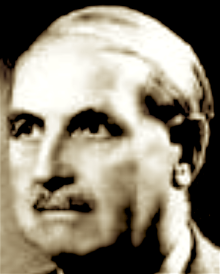
Joseph Emberton was born in Audley, Staffordshire, England on 23 December 1889 and was articled to Chapman & Snape in Newcastle under Lyme (1906-07). Between 1911- and 1913 he studied at the Royal College of Art and the Royal Academy Schools in London.
Following World War One he worked an assistant to Thomas Smith Tait (1882-1954) of Sir John Burnet & Partners from c.1918 to 1922. Between 1922 and 1926, Emberton was in practice with Percy James Westwood (1878-1958), during which time their work included pavilions for the British Empire Exhibition (1924-25), the stands at the Advertising Exhibition in London (1927) and shops for Austin Reed, etc. In the 1930s Emberton was responsible for the design of some of the buildings that are considered icons of the Modern movement in Britain, such as Royal Corinthian Yacht Club, at Burnham-on-Crouch in Essex (1930-32) and Simpson’s Piccadilly in London (1933-34), Blackpool Pleasure Beach Buildings (1933-), and the HMV building on London’s Oxford Street (c.1935). He designed a stand for the advertising agency F.C. Pritchard Wood & Partners at the Advertising & Marketing Exhibition held at Olympia, London, in 1933, and the British Railways Pavilion for the Empire Exhibition in Glasgow in 1938.
In 1955 Emberton designed the ‘Browserie’, a new record store in the HMV building. Emberton. He was elected an Associate of the Royal Institute of British Architects (ARIBA) in 1921 and a Fellow of the Royal Institute of British Architects (FRIBA) in 1931. He died in Westminster, London on 20 November 1956.
In partnership with P. J. Westwood, A.R.I.B.A.: — Various business premises for Messrs. Austin Reed, Ltd., outfitters, etc., at Leeds, Liverpool, Sheffield, Regent Street, and head offices at Red Lion Square; numerous Exhibition buildings at the British Empire Exhibition, 1924 and 1925, including: "State Express" House, Main Avenue and Lake-side Kiosks; in the Palace of Industry, Messrs. Nobel Industries' Stand, the Boot Section, and Messrs. John Jameson's Stand; in the Palace of Engineering, Messrs. British Thomson-Houston Co.'s Stand, etc.; houses in various parts of the country. [Who's Who in Architecture 1926]
_____
See also:
British Listed Buildings [link below]
Historic England [link below]
RIBA Picture Library [link below]
Allinson, Kenneth. Architects and Architecture of London. London: Taylor & Francis, 2008
Casson, Hugh. 'Blackpool'. Architectural Review vol. 86, July 1939 pp. 25-36 [Discusses the new Casino in Blackpool designed by Joseph Emberton]
Directory of British Architects 1834-1914. Compiled by Antonia Brodie, et al. Volume 1: A-K. London; New York: British Architectural Library, Royal Institute of British Architects/Continuum, 2001
Harwood, Elain. Art Deco Britain: Buildings of the Interwar Years. London: Batsford, 2019
Ind, Rosemary. Emberton. London: Ashgate Publishing, 1983
'Obituary'. Architects' Journal vol. 124, 29 November 1956 pp. 57-58
'Obituary'. The Builder vol. 191, 30 November 1956 p. 927
'Obituary'. RIBA Journal vol. 64, January 1957 p. 123
Powers, Alan. Modern. The Modern movement in Britain. London: Merrell, 2005
Thirties: British Art and Design before the War. Thirties: British Art and Design before the War. London: Arts Council of Great Britain, 1979 [Catalogue of an exhibition at the Hayward Gallery, London, 25 October-13 January 1979]
Who's Who in Architecture 1926. Edited by Frederick Chatterton. London: The architectural Press, 1926